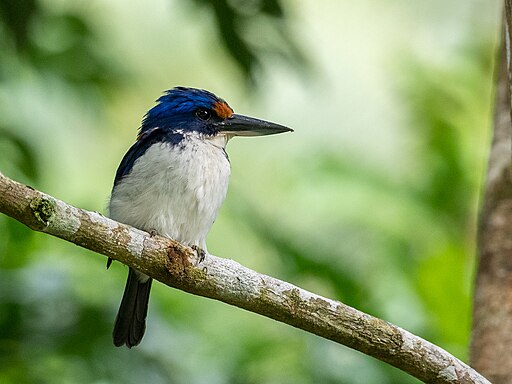Superregnum: Eukaryota
Regnum: Animalia
Subregnum: Eumetazoa
Cladus: Bilateria
Cladus: Nephrozoa
Superphylum: Deuterostomia
Phylum: Chordata
Subphylum: Vertebrata
Infraphylum: Gnathostomata
Megaclassis: Osteichthyes
Superclassis: Sarcopterygii
Superclassis: Tetrapoda
Cladus: Reptiliomorpha
Cladus: Amniota
Classis: Reptilia
Cladus: Eureptilia
Cladus: Romeriida
Subclassis: Diapsida
Cladus: Sauria
Infraclassis: Archosauromorpha
Cladus: Crurotarsi
Divisio: Archosauria
Cladus: Avemetatarsalia
Cladus: Ornithodira
Subtaxon: Dinosauromorpha
Cladus: Dinosauriformes
Cladus: Dracohors
Cladus: Dinosauria
Ordo: Saurischia
Cladus: Eusaurischia
Cladus: Theropoda
Cladus: Neotheropoda
Cladus: Averostra
Cladus: Tetanurae
Cladus: Avetheropoda
Cladus: Coelurosauria
Cladus: Tyrannoraptora
Cladus: Maniraptoromorpha
Cladus: Maniraptoriformes
Cladus: Maniraptora
Cladus: Pennaraptora
Cladus: Paraves
Cladus: Eumaniraptora
Cladus: Avialae
Infraclassis: Aves
Cladus: Euavialae
Cladus: Avebrevicauda
Cladus: Pygostylia
Cladus: Ornithothoraces
Cladus: Euornithes
Cladus: Ornithuromorpha
Cladus: Ornithurae
Cladus: Carinatae
Parvclassis: Neornithes
Cohors: Neognathae
Cladus: Neoaves
Ordo: Coraciiformes
Familia: Alcedinidae
Subfamilia: Halcyoninae
Genus: Todiramphus
Species: Todiramphus winchelli
Subspecies: T. w. alfredi - T. w. mindanensis - T. w. nesydrionetes - T. w. nigrorum - T. w. winchelli
Name
Todiramphus winchelli (Sharpe, 1877)
References
Transactions of the Linnean Society of London (2) 1 p.318 BHL; pl.47. BHL
IUCN: Todiramphus winchelli (Vulnerable)
Vernacular names
català: Alció de Winchell
čeština: Ledňáček Winchellův
English: Rufous-lored Kingfisher
español: Alción cuellirrojo
français: Martin-chasseur de Winchell
Nederlands: Winchells ijsvogel
پنجابی: جنگل مچھی مار
svenska: rostpannad kungsfiskar
Winchell's kingfisher (Todiramphus winchelli[1]) or the rufous-lored kingfisher,[3] is a species of bird in the family Alcedinidae, the kingfishers. It is endemic to the Philippines, its natural habitat being lowland forests. It is threatened by deforestation, and the International Union for Conservation of Nature (IUCN) has assessed it as a vulnerable species.
Taxonomy
This species was described as Halcyon Winchelli by British ornithologist Richard Bowdler Sharpe in 1877, using a specimen collected by American ornithologist Joseph Beal Steere.[4] It was named after American geologist Newton Horace Winchell,[5] as requested by Steere.[4] Although two subspecies were later described, they were usually considered synonymous with the nominate before 1966. That year Kenneth C. Parkes studied a series of 45 specimens and recognised five subspecies, two of which were new.[6] All five are still recognised: Todiramphus winchelli nigrorum found in the central and east-central Philippines, T. w. nesydrionetes in the north-central Philippines, T. w. mindanensis on Mindanao, T. w. winchelli on Basilan, and T. w. alfredi on the Sulu Archipelago in the southwest.[7]
Description
Winchell's kingfisher is about 25 cm (9.8 in) long.[8] The crown is blackish-blue, with cobalt-blue edges, and the lores and neck-collar are rufous.[3] The upperparts are mostly blackish and dark blue, with a bright azure-blue rump. The underparts are white in the male, and buff in the female. The eyes are dark brown, the beak is black, and the legs are greyish. The juvenile bird is similar to the female, but with duller plumage.[8] The subspecies are coloured different shades of blue. A black patch on the sides of the male's breast is conspicuous in subspecies nigrorum and concealed in others, and in nesydrionetes, the female has an orange breast forming a band between the whitish throat and belly.[6][8]
Distribution and habitat
This species is endemic to the Philippines, ranging from Samar and Tablas south to Mindanao, Basilan and the Sulu Archipelago.[8] It appears to be locally common on some islands, but it is rare in other localities.[1] It lives in forest below 1,000 m (3,300 ft) in elevation,[3] being found in coastal lowlands and foothills. Its tolerance of degraded forest is uncertain.[1]
Behaviour
This kingfisher often perches in the canopy and sometimes descends to lower perches and to the ground, probably to feed.[8] One of its calls is an ascending series of harsh chup and chep notes, and another consists of three rising notes and then a long descending series chu chu chu chu.[3] Loud squawking has also been heard.[8] It batters its prey, which consists of large insects, spiders[8] and small vertebrates. Little is known about its breeding.[3] Nesting in a used arboreal termite nest has been recorded.[1]
Status
The population size is estimated at 2,500–9,999 mature individuals, or 3,500–15,000 individuals in total. Forest clearance and illegal logging are causing habitat loss and a fast population decline, so the IUCN has assessed it as a vulnerable species. This species has been recorded in some protected areas, such as Mount Guiting-Guiting and Rajah Sikatuna Protected Landscape.[1]
References
BirdLife International (2016). "Todiramphus winchelli". IUCN Red List of Threatened Species. 2016: e.T22683291A92983266. doi:10.2305/IUCN.UK.2016-3.RLTS.T22683291A92983266.en. Retrieved 15 November 2021.
Gill F, D Donsker & P Rasmussen (Eds). 2020. IOC World Bird List (v10.2). doi : 10.14344/IOC.ML.10.2.
Kennedy, Robert S.; Gonzales, Pedro C.; Dickinson, Edward C.; Miranda, Hector C. Jr; Fisher, Timothy H. (2000). A Guide to the Birds of the Philippines. Oxford University Press. pp. 203–204. ISBN 9780198546689.
Sharpe, R. B. (1877). "On the Birds collected by Professor J. B. Steere in the Philippine Archipelago". Transactions of the Linnean Society of London. 2. 1: 318.
Jobling, James A. (2010). Helm Dictionary of Scientific Bird Names. Bloomsbury. p. 408. ISBN 9781408133262.
Parkes, Kenneth C. (1966). "Geographic variation in Winchell's Kingfisher Halcyon winchelli, of the Philippines". Bulletin of the British Ornithologists' Club. 86: 82–86.
Gill, F.; Donsker, D. (eds.). "Rollers, ground rollers, kingfishers". IOC World Bird List Version 8.1. Retrieved 21 June 2018.
Fry, C. Hilary; Fry, Kathie (2010) [First published 1992]. Kingfishers, Bee-eaters and Rollers. Bloomsbury. pp. 162–163. ISBN 9781408135259.
Retrieved from "http://en.wikipedia.org/"
All text is available under the terms of the GNU Free Documentation License


